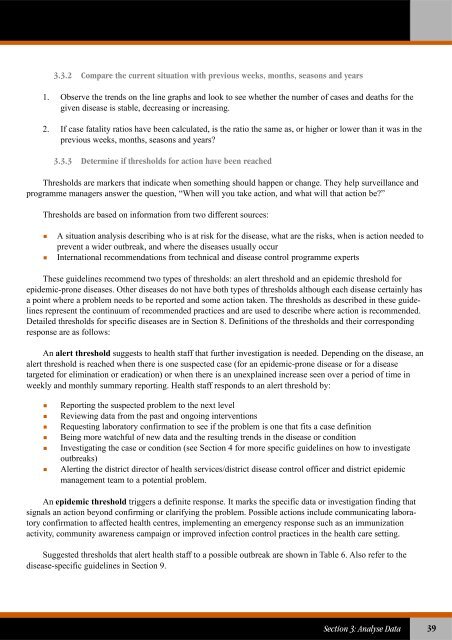Technical Guidelines for Integrated Disease Surveillance ... - PHRplus
Technical Guidelines for Integrated Disease Surveillance ... - PHRplus
Technical Guidelines for Integrated Disease Surveillance ... - PHRplus
You also want an ePaper? Increase the reach of your titles
YUMPU automatically turns print PDFs into web optimized ePapers that Google loves.
3.3.2 Compare the current situation with previous weeks, months, seasons and years1. Observe the trends on the line graphs and look to see whether the number of cases and deaths <strong>for</strong> thegiven disease is stable, decreasing or increasing.2. If case fatality ratios have been calculated, is the ratio the same as, or higher or lower than it was in theprevious weeks, months, seasons and years?3.3.3 Determine if thresholds <strong>for</strong> action have been reachedThresholds are markers that indicate when something should happen or change. They help surveillance andprogramme managers answer the question, “When will you take action, and what will that action be?”Thresholds are based on in<strong>for</strong>mation from two different sources:A situation analysis describing who is at risk <strong>for</strong> the disease, what are the risks, when is action needed toprevent a wider outbreak, and where the diseases usually occurInternational recommendations from technical and disease control programme expertsThese guidelines recommend two types of thresholds: an alert threshold and an epidemic threshold <strong>for</strong>epidemic-prone diseases. Other diseases do not have both types of thresholds although each disease certainly hasa point where a problem needs to be reported and some action taken. The thresholds as described in these guidelinesrepresent the continuum of recommended practices and are used to describe where action is recommended.Detailed thresholds <strong>for</strong> specific diseases are in Section 8. Definitions of the thresholds and their correspondingresponse are as follows:An alert threshold suggests to health staff that further investigation is needed. Depending on the disease, analert threshold is reached when there is one suspected case (<strong>for</strong> an epidemic-prone disease or <strong>for</strong> a diseasetargeted <strong>for</strong> elimination or eradication) or when there is an unexplained increase seen over a period of time inweekly and monthly summary reporting. Health staff responds to an alert threshold by:Reporting the suspected problem to the next levelReviewing data from the past and ongoing interventionsRequesting laboratory confirmation to see if the problem is one that fits a case definitionBeing more watchful of new data and the resulting trends in the disease or conditionInvestigating the case or condition (see Section 4 <strong>for</strong> more specific guidelines on how to investigateoutbreaks)Alerting the district director of health services/district disease control officer and district epidemicmanagement team to a potential problem.An epidemic threshold triggers a definite response. It marks the specific data or investigation finding thatsignals an action beyond confirming or clarifying the problem. Possible actions include communicating laboratoryconfirmation to affected health centres, implementing an emergency response such as an immunizationactivity, community awareness campaign or improved infection control practices in the health care setting.Suggested thresholds that alert health staff to a possible outbreak are shown in Table 6. Also refer to thedisease-specific guidelines in Section 9.Section 3: Analyse Data39















